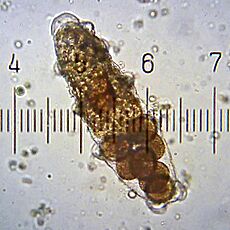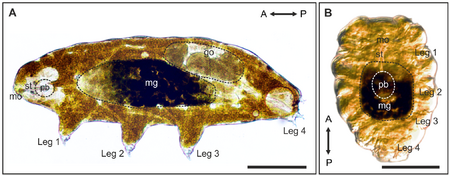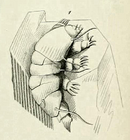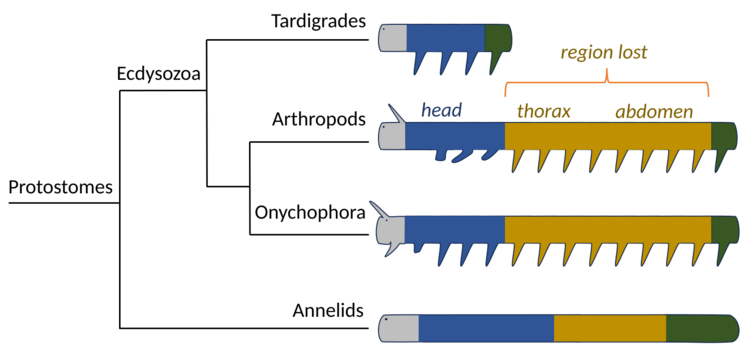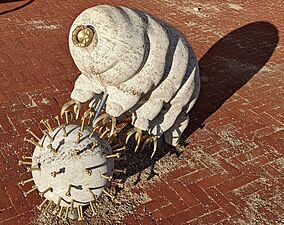Tardigrade facts for kids
Quick facts for kids Tardigrade |
|
|---|---|
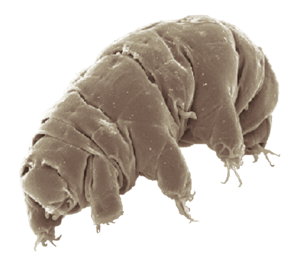 |
|
| Milnesium tardigradum, a type of tardigrade | |
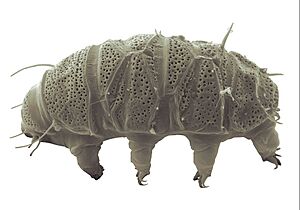 |
|
| Echiniscus insularis, another type of tardigrade | |
| Scientific classification |
|
| Kingdom: | Animalia |
| Subkingdom: | Eumetazoa |
| Clade: | ParaHoxozoa |
| Clade: | Bilateria |
| Clade: | Nephrozoa |
| (unranked): | Protostomia |
| Superphylum: | Ecdysozoa |
| (unranked): | Panarthropoda |
| Phylum: | Tardigrada Spallanzani, 1776 |
| Classes | |
|
|
Tardigrades, better known by their nicknames water bears or moss piglets, are tiny, eight-legged animals that look like plump, microscopic bears. They are some of the toughest creatures on Earth.
The German scientist Johann August Ephraim Goeze first discovered them in 1773 and called them "little water bears" because of their bear-like walk. A few years later, in 1776, Italian scientist Lazzaro Spallanzani gave them the name Tardigrada, which means "slow walkers."
These amazing micro-animals can be found almost everywhere, from the highest mountains to the deepest oceans, and from tropical rainforests to icy Antarctica. They are famous for their ability to survive incredible challenges that would be deadly to most other living things. They can handle extreme heat and cold, a lack of air, and even the vacuum of outer space!
There are about 1,500 known species of tardigrades. They are usually about half a millimeter long, which is smaller than a grain of sand. Because they often live in moss and lichens, you can easily find them and look at them under a simple microscope. Their cute, clumsy walk and amazing survival skills have made them popular in science and culture.
Contents
What Do Water Bears Look Like?
Tardigrades have short, chubby bodies with four pairs of legs. Each leg has four to eight tiny claws that help them grip onto surfaces. Their bodies are covered by a protective layer called a cuticle. As they grow, they shed this cuticle, similar to how a snake sheds its skin.
They don't have lungs or gills to breathe. Instead, they absorb oxygen directly through their body covering. Even though they are so small, their bodies are made of about 1,000 cells.
Senses and Brain
A tardigrade's nervous system is simple. It has a small brain connected to nerve cords that run along its belly, with a nerve center for each pair of legs. Many tardigrades have two simple eyespots on their head that can detect light but can't see images like our eyes do.
Amazingly, scientists have discovered that tardigrades can be trained! This shows that even these tiny creatures are capable of learning.
How They Eat
Tardigrades eat by sucking the juices from plant cells, algae, or other small creatures. They have a pair of sharp, needle-like parts in their mouth called stylets. They use these stylets to poke a hole in their food. Then, a strong muscle in their throat pumps the liquid into their gut.
Life Cycle of a Tardigrade
Most tardigrade species have both males and females that mate to reproduce. The female lays up to 30 eggs at a time. These eggs are often very tough and can survive drying out. In some species, the female lays her eggs inside her old, shed cuticle for protection.
The eggs usually hatch in about 14 days. The baby tardigrades, which look like smaller versions of the adults, break out of their eggshells and begin their lives. Interestingly, some tardigrade species are all female and can lay eggs that develop into babies without any males, a process called parthenogenesis.
Where Do Tardigrades Live?
Water bears are found all over the world. They can be carried long distances by wind or on the feet of other animals, which helps them spread to new places.
You can find them in many different environments, but they especially love damp places like:
- Moss
- Lichens
- Soil
- Leaf litter on the forest floor
They also live in freshwater ponds and in the ocean. In a single square meter of moss, there can be over 2 million tardigrades! They are an important part of their tiny ecosystem, eating smaller organisms like nematodes. They are also food for larger creatures like mites and spiders.
Tardigrade Superpowers
Tardigrades are famous for their ability to survive extreme conditions. They are not "extremophiles" (creatures that love extreme environments), but they are experts at enduring them. They do this by entering a special state of suspended animation.
The 'Tun' State: Pausing Life
When their environment becomes too dry, tardigrades can go into a state called cryptobiosis. They pull in their legs, curl up into a tiny, dried-out ball called a "tun," and shut down their metabolism almost completely. It's like pressing a pause button on life.
In this tun state, a tardigrade can survive for years without food or water. It also becomes incredibly resistant to other dangers, including:
- Extreme Cold: Temperatures as low as -272°C (-458°F), which is almost absolute zero.
- Extreme Heat: Temperatures as high as 149°C (300°F).
- Radiation: Doses of radiation hundreds of times stronger than what would be lethal for humans.
- Extreme Pressure: Both the vacuum of space and the crushing pressure of the deep ocean.
Surviving in Outer Space
In 2007, scientists sent dehydrated tardigrades into space on a mission called FOTON-M3. They were exposed to the hard vacuum and intense radiation of space for 10 days. When they were brought back to Earth and given water, many of them woke up and even laid healthy eggs. This proved that tardigrades could survive the harsh environment of outer space.
In 2019, a spacecraft carrying a container of tardigrades in their tun state crashed on the Moon. It's possible that these tiny, tough passengers survived the impact.
The Secret to Their Strength
So, how do they do it? Scientists discovered that tardigrades produce special proteins that protect their cells. When a tardigrade dries out, these proteins form a glass-like, gel-like substance inside its cells. This "shield" protects the important parts of the cell from being destroyed.
They also have a unique protein nicknamed "Dsup," which stands for "damage suppressor." This protein wraps around their DNA and protects it from being harmed by radiation and other dangers. Scientists are studying these amazing proteins to see if they could be used to protect human cells or make medicines more stable.
Discovering the Water Bear
The first person to see and draw a tardigrade was Johann August Ephraim Goeze in 1773. He was amazed by this tiny "bear" he found in the water. The name "tardigrade," or "slow walker," was given by Lazzaro Spallanzani in 1776.
Over the centuries, many scientists have studied these creatures, slowly uncovering the secrets of their incredible lives.
-
The very first drawing of a tardigrade, made by Johann August Ephraim Goeze in 1773.
The History of Tardigrades
Tardigrade fossils are very rare because they are so small and soft. The oldest known fossils are from the Cambrian period, over 500 million years ago. These ancient relatives had only three pairs of legs instead of four. Scientists believe that tardigrades evolved from larger ancestors and became smaller over time.
By studying their genes, scientists have made a surprising discovery about their body plan. Compared to related animals like insects, a tardigrade's body is almost entirely made up of segments that are like the head region of an insect. They are missing the genes that would create a thorax and abdomen (the middle and end parts of an insect's body). In a way, a tardigrade is like a walking head!
-
A model of an ancient tardigrade from the Cambrian period, about 500 million years ago.
Water Bears in Pop Culture
Tardigrades have become surprisingly popular. Their cute appearance and amazing survival skills have captured people's imaginations. Because they are easy to find in moss, they are a favorite subject for students and amateur scientists.
You can now find tardigrades on all sorts of merchandise, like t-shirts, earrings, and stuffed animals. There are even crochet patterns so you can make your own water bear! Their fame shows how even the smallest creatures can be fascinating and inspiring.
Images for kids
See also
 In Spanish: Tardigrada para niños
In Spanish: Tardigrada para niños



